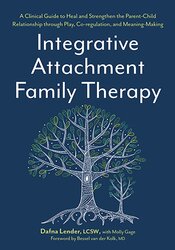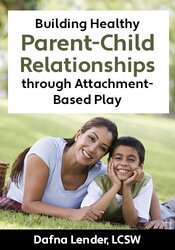Unlocking Emotional Synchrony in Parent-Child Relationships

The key to a healthy parent-child relationship is connection. A parent first connects with their child the first time they hold their baby to their chest. Their heartbeats sync, forming a genuine connection. Throughout the child’s life, the parent must learn to regulate their child, just as they had harmonized their heartbeats from the very first moment. Integrative attachment family therapy (IAFT) is a multidimensional framework to help strengthen the parent-child relationship.
IAFT is rooted in the body and works with the nonverbal, nonconscious energy exchanged between the parent, the child, and the therapist. This transformative intervention is designed to address a wide range of common issues that bring parents and children to therapy, like lying, controlling and manipulative behaviors, defiance, frequent tantrums, and seemingly pointless disobedience. Additionally, IAFT is effective in treating internalizing symptoms, such as indifference, disconnection, boredom, and depression.
The power of IAFT lies in its ability to address the core issues that bring a child to therapy: a fundamental disconnect in the parent-child relationship where the child feels neither deeply understood nor accepted by the parent. By addressing this core issue, IAFT reduces tantrums, defiance, and other unwelcome child behaviors. This allows families to look beyond superficial treatments and begin to understand the underlying sources of conflict. This article explores various components of IAFT and examines how children may respond to the therapy.
Understanding and expanding a child’s window of tolerance is essential for fostering resilience and emotional stability. When children operate within their window of tolerance, they are better equipped to manage stress, exhibit positive behavior, and build healthy relationships. In this case, IAFT can help children recognize and regulate their emotions, gradually widening their window of tolerance. This process supports their immediate well-being while laying the foundation for long-term emotional health and adaptive coping strategies.
The parent's response to a child's emotions can either heighten or lessen their feelings:
This state of calmness allows the child to experience and express feelings of love, compassion, and closeness with their parents. By staying within this optimal range of emotional and physiological arousal, children are better able to connect with their parents, fostering a secure and nurturing relationship. This emotional stability not only enhances their immediate well-being but also contributes to their long-term emotional and psychological development, promoting healthier interactions and stronger family bonds.
IAFT is rooted in the body and works with the nonverbal, nonconscious energy exchanged between the parent, the child, and the therapist. This transformative intervention is designed to address a wide range of common issues that bring parents and children to therapy, like lying, controlling and manipulative behaviors, defiance, frequent tantrums, and seemingly pointless disobedience. Additionally, IAFT is effective in treating internalizing symptoms, such as indifference, disconnection, boredom, and depression.
The power of IAFT lies in its ability to address the core issues that bring a child to therapy: a fundamental disconnect in the parent-child relationship where the child feels neither deeply understood nor accepted by the parent. By addressing this core issue, IAFT reduces tantrums, defiance, and other unwelcome child behaviors. This allows families to look beyond superficial treatments and begin to understand the underlying sources of conflict. This article explores various components of IAFT and examines how children may respond to the therapy.
Co-Regulation & Attunement
The root of a genuine parent-child connection is co-regulation. Co-regulation is a characteristic of connection that refers to a parent's ability to non-verbally and unconsciously understand and regulate their child’s emotions; this occurs through the process called attunement. Attunement is the method of becoming aligned with and responsive to another's feelings and needs. This understanding does not need verbal communication, but instead relies solely on body language, facial expressions, and tone of voice to communicate emotions. Attunement allows a parent to join their energy with their child and communicate their care and compassion without having to explain their feelings. In turn, having felt love and belonging from the parent, the child is less likely to act out due to this intimate comfort.Window of Tolerance
The window of tolerance is a concept that describes the range of emotional and physiological arousal within which a person can function effectively and feel comfortable. A child's window of tolerance is far smaller than an adult’s window because they are still developing their emotional regulation systems and are often more reactive. Because of this, exploring a healthy window of tolerance is crucial for their emotional and psychological well-being.Understanding and expanding a child’s window of tolerance is essential for fostering resilience and emotional stability. When children operate within their window of tolerance, they are better equipped to manage stress, exhibit positive behavior, and build healthy relationships. In this case, IAFT can help children recognize and regulate their emotions, gradually widening their window of tolerance. This process supports their immediate well-being while laying the foundation for long-term emotional health and adaptive coping strategies.
Putting It Into Practice
When a parent practices co-regulation, they begin by attuning to their child’s current mental state. To do this, the parent must become aware of the child’s emotional and physical cues, such as facial expressions, body language, and tone of voice. Once they have become attuned, the parent makes a largely unconscious decision about how to respond. They might choose to simply acknowledge the moment, or they might actively engage with the child. Their response to their child communicates the message, “I see you; I’m with you.”The parent's response to a child's emotions can either heighten or lessen their feelings:
- Increasing the affect:
- When a child is experiencing joy or positive emotions, the parent can enhance this by using enthusiastic facial expressions, gestures, and an upbeat tone of voice.
- Decreasing the affect:
- If the child is upset, uncomfortable, or feeling overwhelmed, the parent should aim to soothe them. This can be achieved through a softer tone, gentle touch, and calming gestures.
- Facial expressions: Smiling, frowning, or showing concern.
- Gestures: Hugging, patting, or holding the child.
- Posture: Leaning in to show attentiveness or sitting back to give space.
- Eye contact: Maintaining or avoiding eye contact based on what the child needs.
- Tone of voice: Speaking softly to calm or energetically to engage.
This state of calmness allows the child to experience and express feelings of love, compassion, and closeness with their parents. By staying within this optimal range of emotional and physiological arousal, children are better able to connect with their parents, fostering a secure and nurturing relationship. This emotional stability not only enhances their immediate well-being but also contributes to their long-term emotional and psychological development, promoting healthier interactions and stronger family bonds.
Integrative Attachment Family Therapy

Instead of viewing the child as the problem, Integrated Attachment Family Therapy (IAFT) addresses the crux of the issue: a misalignment in the parent-child relationship. In this treatment guide, Dafna walks readers through the IAFT framework, providing therapeutic insight and concrete strategies to help families achieve meaningful and lasting change.
Whether you’re a clinician, child welfare worker, educator, or professional working with children in any capacity, this must-have resource will allow you to:
Whether you’re a clinician, child welfare worker, educator, or professional working with children in any capacity, this must-have resource will allow you to:
- Create a strong alliance with parents – the crucial, and often missing, piece of therapeutic work with children
- Overcome a host of complex, off-putting defenses and dysfunctions that come with working directly with parents
- Uncover the reasons for the emotional misalignment between parent and child
- And so much more!
Digital Seminar: Building Healthy Parent-Child Relationships through Attachment-Based Play

Play-based methods of engagement tap into children’s natural medium to provide moments of learning, joyful connection, regulation, and positive connection.
The quickest and most powerful way to get to transformative moments with children is through interactive, face-to-face, reciprocal, cooperative interactions that rely on movement, rhythm, touch, a prosodic voice, and eye contact. In this digital seminar, we'll utilize embodied play and mindfulness exercises to strengthen the bond, safety, and trust between parent and child.
The quickest and most powerful way to get to transformative moments with children is through interactive, face-to-face, reciprocal, cooperative interactions that rely on movement, rhythm, touch, a prosodic voice, and eye contact. In this digital seminar, we'll utilize embodied play and mindfulness exercises to strengthen the bond, safety, and trust between parent and child.
Meet the Experts:
Dafna Lender, LCSW, is an international trainer and supervisor for practitioners who work with children and families. She is a certified trainer and supervisor/consultant in both Theraplay and Dyadic Developmental Psychotherapy (DDP) and an EMDR therapist. Dafna’s expertise is drawn from 25 years of working with families with attachment in many settings: at-risk after school programs, therapeutic foster care, in-home crisis stabilization, residential care and private practice. Dafna’s style, whether as a therapist or teacher, is combining the light-hearted with the profound by bringing a playful, intense, and passionate presence to every encounter.
Learn more about her educational products, including upcoming live seminars, by clicking here.
Learn more about her educational products, including upcoming live seminars, by clicking here.



